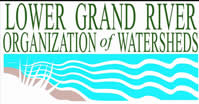Lower Grand Watershed Interactive Tool (WIT) - Agricultural Drains

FYI on Local Water Issues
Agricultural drains are man-made ditches or natural water bodies that have been "improved" that drain water. The water can come from either precipitation or irrigation. These drains connect to rivers, streams, or lakes. Without agricultural drains, most of Michigan would still be a swamp. These ditches often lack riparian vegetative cover, are narrow, and very shallow. This can lead to a variety of problems such as nutrient loading, sediment and thermal pollution.
- Nutrients come from storm water runoff from agricultural fields that use fertilizers. If there is little or no riparian buffer (vegetation), fertilizers and animal waste are flushed into the drainage ditch to flow into a main body of water. Nutrients lead to algal blooms and when these blooms die off the decomposition process depletes the oxygen supply in the water. When the oxygen is depleted, it kills off fish and other aquatic insects. Excess nutrients in the water can also cause major health problems in humans.
- Sedimentation pollution occurs when the rain water is shuttled through drains and flows rapidly into a water body, often eroding the bank. This rapid flow unnaturally changes the hydrology of the area by adding large volumes at very quick rates. This process causes erosion on streambanks. Sedimentation threatens aquatic species, riparian landowners, and water quality. Sedimentation is very costly to repair.
- Thermal pollution can occur in slow shallow agricultural drains. The water heats up because of the lack of a vegetative canopy. When this slow-moving warm water reaches a main water body it changes the water temperature, which in turn lowers the water's holding capacity of oxygen.
Agricultural drains can be very useful if they are properly maintained. Properly maintained agricultural drains allow the land to be farmed by preventing flooding or standing water.
For more information on agricultural drains, consult the following resources:
- The Drain Primer: Guide to Maintaining and Conserving Agricultural Drains and Fish Habitat
- Pollutants associated with agricultural drains
- Planning an Agricultural Subsurface Drainage System
- Ohio State University Extension bulletin on Agricultural Drainage - Water Quality Impacts and Subsurface Drainage Studies in the Midwest
- Status and Importance of Drainage
- Understanding Agricultural Drainage
- MDEQ Wetland Restoration
